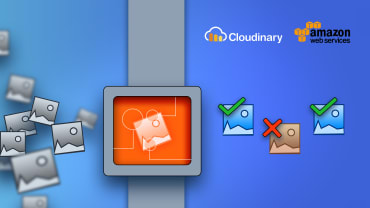Allowing your users to upload their own images to your website can increase user engagement, retention and monetization. However, allowing your users to upload any image they want to, may lead to some of your users uploading inappropriate images to your application. These images may offend other users or even cause your site to violate standards or regulations.

Here at Cloudinary, we provide a cloud-based tool that enables our users to compress images and video for their websites and apps. Our goal is to preserve the visual integrity of the content, but deliver the smallest file size to any device or browser to ultimately optimize website performance and end user satisfaction.

Developing applications for mobile consumption requires facing, and overcoming, some difficult challenges. Apps need to limit their RAM, CPU and battery usage while still performing the required tasks in a reasonable time frame. If too many background tasks are running, the mobile device can become sluggish, with the battery running out very quickly. Coordination with other apps is crucial to keep the device responsive and make the battery last longer.

TL;DR
Since Google shared their intent for the next billion internet users, some African developers thought this was pointing right at them and they needed to act fast. The mission to bring the next billion users from Africa to the internet kicked off a storm of enthusiasm. This community event turned into a success story and this is a summary of what happened.

TL;DR In our last article, we saw how Cloudinary is the perfect email image hosting solution for launching email marketing campaigns at scale. Today, we’ll explore this topic further, looking at how Cloudinary can create dynamic image banners that can be used to create highly personalized email marketing campaigns.

There are a lot of cool and useful marketing technology and tools available today. As a part of the marketing team at Cloudinary, we must identify and recommend the solutions that will scale and optimize our ability to reach, and effectively engage with, our prospects. One of the most critical tools, perhaps, is a digital asset management (DAM) solution, which I discussed in an earlier article here.

We know what it’s like being a start-up, and whether you're running a new venture, or part of a team in a large company - we want to make your life easier and your media shine. Our proposal? Kick off your project with a HUGE free plan, no strings attached.

Cloudinary offers an interesting feature: The ability to generate images from the PDF files and pages. With Cloudinary, you can create thumbnail images of your documents for previewing purposes. It's useful when you don't want to grant user access to the content, but need to give them a sneak peek of what they're missing if they haven’t downloaded the PDF yet.

Welcome to the latest edition of the Responsive Images Guide!
In part 1, I laid out the big idea: a responsive image is a variable image – which adjusts itself to fit variable contexts.
In part 2, we looked at the most common way that an image can do exactly that: scaling itself up and down to fit viewports of different sizes and screens with different densities.

For the last few years I’ve been active as a member of the Silicon Valley chapter of Women Who Code, a nonprofit that encourages women in tech careers. I’ve loved being a part of it, meeting new people, working with mentors and going to meet-ups where I can learn skills or become more proficient in my iOS expertise.
